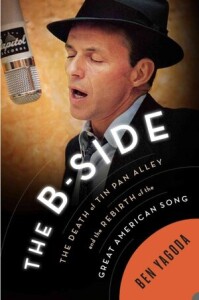 “They don’t write songs like that anymore!” You’ve probably said that about some song from your own youth or young adult years, just as your parents and maybe even grandparents said about their old favorites. Every generation says this about all kinds of stuff, not just their own popular music, and they’re always wrong, right? I mean, kids these days, amiright?
“They don’t write songs like that anymore!” You’ve probably said that about some song from your own youth or young adult years, just as your parents and maybe even grandparents said about their old favorites. Every generation says this about all kinds of stuff, not just their own popular music, and they’re always wrong, right? I mean, kids these days, amiright?
Well, according to Ben Yagoda in his book The B-Side, yes and no. That’s always the case when it comes to history, especially cultural history.
Yagoda is a journalism professor at the University of Delaware and a prolific writer and author on a variety of topics. This is at least the third book of his I’ve read (but the first I’ve sat down to review). The others include When You Catch an Adjective, Kill It: The Parts of Speech, for Better and/or Worse, and About Town: The New Yorker and the World It Made; he’s also written Memoir: A History, Will Rogers: A Biography, and he co-edited The Art of Fact: A Historical Anthology of Literary Journalism.
Within the scope of a book that’s short enough to be interesting (and affordable) as popular non-fiction, The B-Side is a sweeping but detailed history of popular music in America in the 20th century. He shows us how the songs that make up what we now call the Great American Songbook were created through the intersections of art, commerce, technology and economics, oh, and luck; and how American songs and music changed along with those and other historical factors.
The book is not just clearly written but well organized. After a sharp prologue that sets out his premises, Yagoda introduces us to the lyricists and tunesmiths who – though they didn’t know they were doing it – birthed the American Songbook in the 1920s through the 1940s. How and why the hitmakers moved from Broadway to Hollywood and eventually back again. He details how the newly powerful producers like Mitch Miller saw (and helped create) the change in Americans’ musical tastes in the 1950s. And he shows how the Standards survived and even came to thrive quietly in the background as rock and roll (and later just “rock”) took over the imaginations of American music fans.
Along the way we meet the big names of the golden era of the American Songbook: Richard Rodgers, Lorenz Hart, Cole Porter, Jerome Kern, Oscar Hammerstein III, Harold Arlen, and Yip Harburg. And the later generations of Tin Pan Alley songsmiths who competed to write rock and roll hits: Carole King and Gerry Goffin, Barry Mann and Cynthia Weil, Burt Bacharach and Hal David, and more.
Most importantly, Yagoda shows us how these rather unlikely folks, most of them New Yorkers of Jewish immigrant families, came to create songs that initially were a flash in the pan like most pop music, but somehow live on today. How they moved from the Broadway stage to the Hollywood screen, onto records and the radio, into the repertoires of jazz musicians and rock stars alike, and continue to move those who sing them and hear them. If you, like me love reading books on music lore, you should definitely give The B-Side a spin.
(Riverhead Books, 2015)
